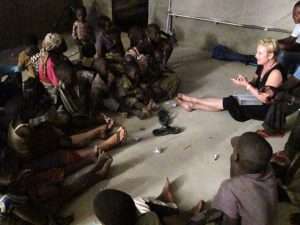I found out what was wrong with my butterfly. It was afflicted with something called OE spore. I found out about it at mymonarchguide.com. Here’s the page that tells about it.
I was glad to know that we didn’t do anything wrong to cause my butterfly to die. But it was still sad. We had 4 caterpillars, including the one we gave to our neighbors. Two of them were crippled by OE spore and were unable to get out of their chrysalises and their wings were shriveled and useless. Two of them were perfect, and we had a very happy experience with them.
I wanted to put some links together for others who might want to raise monarch butterflies or at least show their children how the process happens.
1. Find a monarch caterpillar. Where can you find a monarch caterpillar?
On a milkweed plant
Here’s what a baby monarch caterpillar looks like:
Here is a site about the different types of milkweed, so you can look around and see what kind of milkweed grows near you.
http://www.butterflyencounters.com/milkweedphotos/index.html
2. You need to gather milkweed regularly for about 2 weeks to feed your caterpillar. They like their food fresh!
Ours really liked to eat the flowers. We had swamp milkweed near us.

Pictured is a type of milkweed called Butterfly Weed. Its scientific name is: Asclepias Tuberosa
3. How do you know when a caterpillar is ready to become a chrysalis?
He stops eating and starts roaming around looking for a place to hang upside down. He will attach himself to a surface and hang upside down in a J shape.
Then after a couple of hours, he will start to turn green. Here is a video you can watch to see what this process looks like. Prepare to be amazed!
Here’s a time-lapse video, if you’re pressed for time!
4. Then you have to wait another 2 weeks or so (sometimes not that long) before they are changed into a butterfly and come out of the chrysalis. The process of coming out of the chrysalis is called eclosing.
Here is a video of a monarch coming out of its chrysalis.
5. After your butterfly ecloses from the chrysalis, you can take it outside in the sun to let it dry its wings and get ready to fly. This will probably take a couple of hours before it will try to fly. We put ours up in a tree.
And make sure you check out the best site of all – mymonarchguide.com – for learning all you ever wanted to know about monarch butterflies.
Take note of the cute dog in the header with the monarch butterflies landed on it. It’s so cute!!!












 "Oh that God would give every mother a vision of the glory and splendor of the work that is given to her when a babe is placed in her bosom to be nursed and trained! Could she have but one glimpse in to the future of that life as it reaches on into eternity; could she look into its soul to see its possibilities; could she be made to understand her own personal responsibility for the training of this child, for the development of its life, and for its destiny,--she would see that in all God's world there is no other work so noble and so worthy of her best powers, and she would commit to no other's hands the sacred and holy trust given to her." -JR Miller
"Oh that God would give every mother a vision of the glory and splendor of the work that is given to her when a babe is placed in her bosom to be nursed and trained! Could she have but one glimpse in to the future of that life as it reaches on into eternity; could she look into its soul to see its possibilities; could she be made to understand her own personal responsibility for the training of this child, for the development of its life, and for its destiny,--she would see that in all God's world there is no other work so noble and so worthy of her best powers, and she would commit to no other's hands the sacred and holy trust given to her." -JR Miller







This was wonderful! Thanks Penney. The kids and I have visited our Butterfly Pavilion at the Natural History Museum for four years now. They love drawing the butterflies in their nature journals. Our favorite books about the Monarchs and butterflies: Monarch and Milkweed by Helen Frost; Where Butterflies Grow by Joanne Ryder; and Butterflies in the Garden by Carol Lerner.
One day we will try this! Thanks for sharing your experience. We’ve not done well with bringing tadpoles and bugs and things in our home. They usually die. :-(. But I definitely want to try a monarch sometime.
Caterpillars have been the most resilient bugs we’ve had. You just have to observe what kind of plant you found the caterpillar on and keep getting fresh leaves and parts of the plant and watch to see that they’re eating. It gives the kids something to do during the summer!
We got what we thought was an egg from a milkweed plant and we ended up with 8 caterpillars! Thank goodness they were in a large terrarium that could accommodate them all. This is a great perennial project to rekindle our sense of natural wonder.
We raised painted lady butterflies a few years ago. We would LOVE to do this again. There is lots of milkweed growing in our area, I keep looking for monarchs.